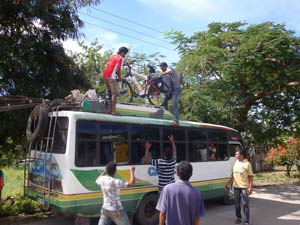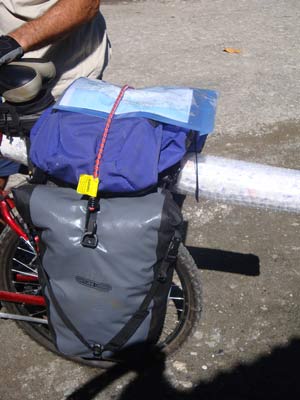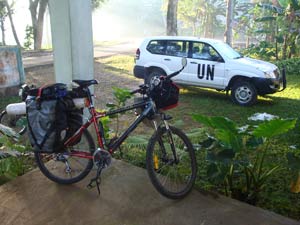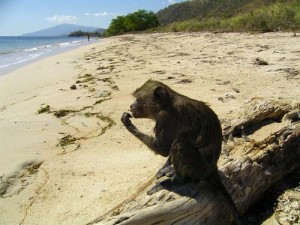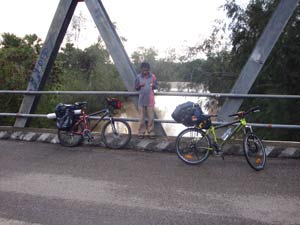CYCLE TOUR
| Baucau Com Lospalos Viqueque Vamase This circuit takes takes you around the Eastern half of Timor Leste.The trip starts with an early morning bus trip from Dili to Baucau. Then an easy ride along the coast to the resort town of Com. The route then climbs up onto the Lospalos plateau and east past caves and an underground river to Jaco Island at the eastern tip of Timor, then south of Lake Illalalaro through a very isolated area to Lospalos.Then south to Lore on the Timor Sea, with a very difficult section to Illioma. Alternatively there is an easier road that follows the ridges down to Illioma from Lospalos, and then an easy ride along the south coast, through Uatolari to the provincial town of Viqueque.It is a hard climb or bus ride up to the the pass over the dividing range near Venilali, followed by a rewarding downhill ride through beautiful country back to Baucau and down to the coast to the end of the ride at Vemase.The total ride is four hundred kilometres, taking two to three weeks to complete. Various sections of the circuit could be ridden to tailor the length of the ride to personal requirements. For example, a ride from Baucau to Com and Jaco island then Lospalos and return to Baucau could be easily completed in a week. 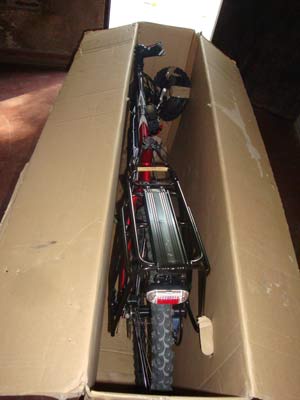
BIKE IN BOX DILI MOUNTAIN BIKE CIRCUIT Ride B; Com – JacoIsland – Lospalos Ride C; Lospalos -Illioma- Viqueque Ride D; Viqueque -Baucau- Vemase. Dili to Baucau. The buses going through Baucau leave Dili early each morning. To be sure of a seat you need to get to the departure point at four am. Ask them to put the bikes on the roof on top of everything as this is more secure and less likely to damage the bikes than on the rear racks. Stow any loose items in securely tied rice sacks. The buses will nor leave until full and this may take hours; ours left at seven am from the eastern end of Becora at the foot of the mountain and arrived at the top market in Baucau three hours later. The reason for not commencing the ride from Dili is that the narrow coast road from Dili to Baucau is cut into cliffs in places with a safety barrier on the outside. Trucks come around these blind corners with their horn blasting to announce their presence. This is a serious safety issue, if you happened to be where two trucks are passing on the bend there is nowhere to go and you may be squashed against the barrier. (This road was being reconstructed in 2017.) Accommodation and food is readily available in Baucau, also an ANZ bank ATM, and Internet connection at Buka Hatene, neighberhood house. If you intend riding the complete circuit I suggest you inform the police in Baucau of your E.T.A. in Lospalos and Viqeuque. Report to the police at both towns then report out at Baucau on your return. UNLOAD BIKES BAUCAU Equipment Bike A good quality medium prices bike packaged for the flights. We had no breakdowns. Suspension Front only, ridged rear is ideal for attaching the load. Racks Strongest available and carry spare mounting bolts. One of mine sheared off at the base mount, but it is possible to fix with a motor bike bolt. Even in remote areas some of the shops carry a small range of spares for motor bikes. The thread was not quite right but it did the job. I found my large waterproof Ortlieb rear bags ideal although the fasteners are a bit fragile and due to the rough treatment the inserts fell off, so spares need to be carried. They still worked okay but the bags were loose on the frame. A day backpack was strapped on top of the bags with the maps in a plastic folder on the very top. A five litre Tioga camera type bag was attached on the handlebars by a quick release clip. This was the mobile office. On steep climbs the outfit could have done with a little more weight up front. My guide Carlito had a local rack and tied the camping gear on top of it. We spotted a local carrying water containers tied below cross sticks he had lashed to his wooden rack (see photo page ?). We thought this a good model and got some sticks from a carpenter then tied them onto Carlito’s rack with cable ties. We then slung part of his load below, thus lowering the centre of gravity. Brakes Disc, ideal in muddy conditions. Gears Twenty four speed, but it would have been handy to have one gear even lower. Under muddy conditions the drive train required daily washing, drying and oiling. Tires and Valves Heavy duty with a medium tread, carry a spare tyre and two tubes. We only had one puncture in 400 kilometres. Ensure you have car-type valves so you can access motorbike pumps and the cap doubles as a valve tool. Pedals and Toe Clips I had toe clips, this was okay on the good roads but they needed to be strapped up in the mud and used upside down. The stitching in my new shoes gave way in the south coast mud so sandals were used for the rest of the ride. They worked best without toe clips. Helmet Open well ventilated with some sort of sun protection, I cut the centre out of a felt hat and put the brim under the helmet on sunny days. Gloves Padded with open fingers are ideal for the rough road surface and protection against mosquito attacks. Lights Bright flashing front and rear are required. Timorese drivers are not used to bike lights so it makes you a lot more visible. Front can be detached and used as a torch. |
Repair Kit Tyre repair patches, glue and levers. Allen key set. Spanner to fit pedals and wheel nuts. Multi purpose (Swiss army)type knife tool. Chain oil. Cable ties. Spoke spanner. Spares Chain joiner (the chain, etc. must be in top condition). Inner brake and gear cables. Spokes front and rear. Spare bolts for rack mount. Extras Trip computer. One water bottle and cage plus large locally produced aqua. bottle, available at every village. Pump. Quick release nuts on the seat and axles are handy if the bike needs to go into the back of a 4WD. Health and Safety Friendly and unthreatening We were on and off the roads, sometimes in trackless areas living with the poorest of people and never felt threatened at any time, and were mostly ignored by the dogs. Groups of children walking on the road to school are very friendly and tend to rush over and want to touch the rear of your bike, possibly upsetting the balance, shouting only seems to encourage them. If riding quickly you can sometimes sneak up behind them then call out at the last second and as they part ride through before they can regroup and catch up. Another road hazard is livestock, although the chickens are quick enough to get out of the way. First Aid It is essential to carry a trekker’s first aid kit,and some first aid knowledge. Clinics and Hospitals All towns appear to have a clinic. Many are staffed by a nurse with regular visits by a doctor. This is still part of the developing world so the service is quite basic. There are many Cuban trained doctors who speak Spanish. The doctors we spoke to were concerned about insufficient backup of medical supplies.
Malaria and other nasties. Medical advice and extreme care is required on the old overgrown south coast road that runs through the rain-forest from Lore to Illioma, due to the presence of aggressive cerebral malaria carrying type mosquitoes in this area. You might find it easier and safer to take the alternative route that follows the ridges between Lospalos and Illioma to avoid the rain-forest route after heavy rain, because the river crossings in this area are then impassable as there are very few bridges. The rivers are short so the water level drops quickly. Observations In the remote districts there have been many improvements in the past four years. Most noticeable are: New schools in most villages The buildings are very well constructed with quality seals on the louvers to keep out the mosquitoes. A septic toilet system with running water is provided, New community meeting halls. Most small villages now have an open, roofed meeting area with a satellite dish and television screen. The power is supplied by two or more solar panels and two large batteries. Bridges The south coast is an area of very high rainfall. This has resulted in many bridges being washed away, as there has been very little maintenance in the past sixteen years There has been a massive bridge building programme and the mostly Chinese contractors have constructed large steel truss fabricated bridges. Now almost all of the rivers are bridged. There appears to be a standard design with extra piers and sections over the wider rivers. This is a huge achievement as access roads are often non existent.
Roads Due to lack of maintenance and the use of vehicles far too heavy for the lightly constructed roads, the network is collapsing in many districts. However a bike only needs a narrow strip to ride on, and so manages easier than a car. The number one concern expressed over and over to us by community leaders was the need for access by small trucks to get produce to markets and move people and goods around the districts. Now that the bridges are in place the government is undertaking a major road reconstruction program. Communications The mobile telephone system now operates over most of the country particularly from hilltops. Travellers Most individuals and couples I spoke to hire a motor bike, visit the districts and trek the mountains for a few days. Some who have been working in Australia come over to visit East Timor where they get an Indonesian passport (this can take up to a week), then catch a bus to Kupang and take the ferry to travel further up into Asia. There are also travellers doing the reverse, ending up in Australia having worked their way down through Asia. The groups seem to spend a few days in Dili then do a 4WD tour and trek or dive with one of the local companies. NGOs A few NGOs are still doing great work in Timor Leste. |
